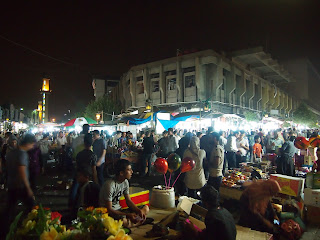A large American cruise ship had appeared in Yalta bay overnight and Sergey had been prebooked to spend the day shepherding Americans around. As a result we were going to be on our own today in Yalta and the surrounding area. Yalta is a world famous city despite its relatively modest size due to the conference held there in 1945 between the USA, USSR and Great Britain (represented by Roosevelt, Stalin and Churchill respectively), to decide the fate of post-war Europe. The conference was held in Yalta because the area is full of the large country houses (dachas) of rich Russians. Unfortunately, the stately homes are all located in the hills around the town and are difficult to get to for people who aren’t on an American tour bus.
 |
| Moorish architecture at Vorentovsky Palace |
 |
| Livadia Palace, location of the Yalta Conference |
The whole process had taken a lot of time due to the complexity of the public transport system so we decided to head back to Yalta on yet another bus. In keeping with my standard 'tour guide’ routine, I had totally forgotten to factor in lunch, so everyone was pretty hungry by this stage. We were dropped off at Yalta bus station and then headed for the town’s McDonalds. As uncultural as it sounds, there are few McDonalds outlets that are as cultured as the one in Yalta. The reason for this, is that it is the only outlet in the world built on a square named after Lenin. We sat on the rooftop terrace, eating our Big Macs with a rather forlorn looking statue of Lenin looking directly at the building - the ultimate symbol of capitalism versus communism. We decided to go back to the hostel to chill out for a bit before our last night in Yalta - we are staying at the Sobhaka Hostel which is very pleasant but quite far from the centre. This isn’t helped by the fact that the street map of Yalta looks like Mr Tickle, making getting home quite a challenge. That night we went to a fantastic fish restaurant called Khutorok La Mer, right on the front by the beach. Tomorrow we are meeting Sergey again for our last full day in Ukraine.
 |
| Dinner in Yalta |













































